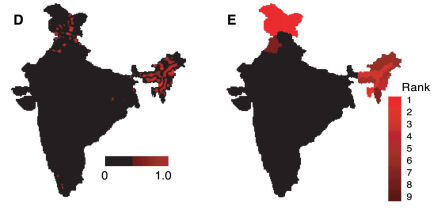The Essence of Group Conflict
Separation with poorly defined boundaries leads to ethnic violence
- More than 2 years ago
To predict where hatred among different groups of people will erupt into violence, you don’t need to know the reasons for their grudges. Nor do you need to analyze the local economics, the character of the peoples, or the behavior of neighboring countries, a new mathematical analysis concludes. The study predicts ethnic violence with remarkable accuracy using only one factor: the geographical distribution of the groups.


Yaneer Bar-Yam and colleagues at the New England Complex Systems Institute in Cambridge, Mass., hypothesized that cultural differences are more likely to lead to conflict when groups are mixed together to a moderate extent. When groups are very well integrated, the different factions don’t form strong separate identities, and they don’t view public spaces as belonging to one group and not the other. So the researchers guessed that they would probably get along well. Similarly, when groups are very well separated, they tend not to fight, because they don’t encroach on one another.
It’s when the groups are somewhat separated and the boundaries are poorly defined that trouble is almost inevitable. When groups have strong, distinct cultures, they want everyone in their public spaces to follow their cultural norms. The researchers figured that fuzzy boundaries would lead to conflict over whose customs should dominate and where.
To test their hypothesis, Bar-Yam and his colleagues decided to try to retroactively “predict” where violence occurred during recent conflicts in the former Yugoslavia and in India.
For Yugoslavia, they used census data that was taken in the early 1990s, before the conflict began, and in India, they used census data from 2001. No later census data was available, so they created a mathematical model to simulate migration habits over time, with the assumption that, particularly during periods of conflict, people gradually move toward people of their own ethnicity or social group. Similar models are used to describe physical phenomena, such as the way that oil and water separate if they are mixed.
After running the simulation, the researchers identified small islands and peninsulas where one group was surrounded by another as areas of likely conflict. Their predictions had a 90 percent correlation with news reports of actual regions of conflict during the war in Yugoslavia. For India, the correlation was even higher, 99.8 percent. The researchers report their results in the Sept. 14 Science.
Timothy Gulden, a political scientist at the University of Maryland at College Park, says that the model helps demonstrate how violence forms and progresses. He also says that the dynamics used to create the model have been observed empirically in areas at war. “In Iraq, for example, we see an emergence of segregation among a population that used to live reasonably peaceably together,” Gulden says. “Once the violence started, areas started tipping Sunni or Shia, and the more they tipped, the more they tipped.”
Bar-Yam says that the ability to predict from such limited information doesn’t mean that no other factors are relevant. It does suggest, however, that the degree of mixing among different ethnic groups is a powerful determinant of violence. Bar-Yam also argues that it shows that “ethnic violence is not an individually driven behavior. It doesn’t happen because someone decides to do something, though it may be triggered by individual behavior. It’s a collective behavior that arises from understandable forces.”
The researchers say the results suggest that policymakers can address the potential for ethnic violence by either encouraging mixing or developing clear boundaries. The researchers point to Singapore as a successful example of the former approach. Regulations there specify that ethnicities must be mixed in public housing blocks, where 84 percent of residents live. This assures the kind of mixing that discourages violence, and the researchers point out that ethnic violence in Singapore is rare, despite social tensions. Bar-Yam acknowledges, though, that this peacefulness comes at the cost of an authoritarianism most would find unacceptable.
“The tremendous tragedy and suffering that are happening in places like Darfur and [elsewhere] means that there is an imperative to apply new scientific tools to these problems,” Bar-Yam says. “This research points to specific things that are key factors, and policymakers should consider these results in determining policies that will be effective.”
If you would like to comment on this article, please see the blog version.






